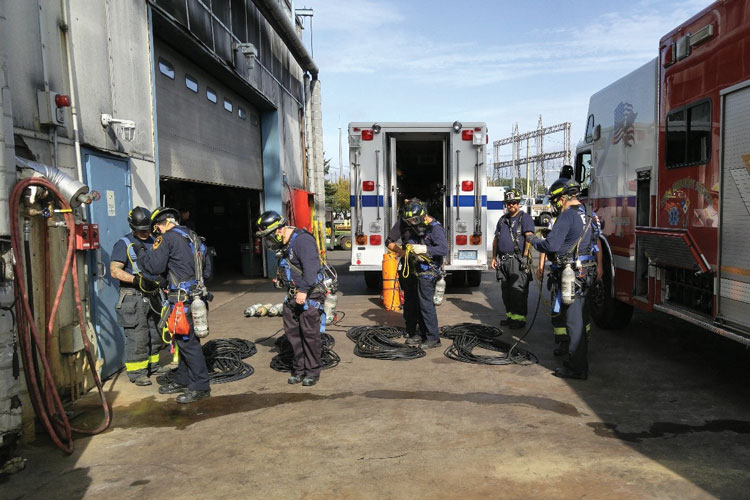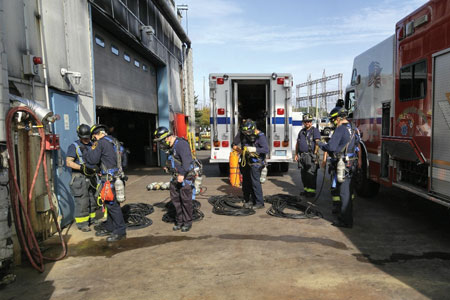
BY AARON J. HELLER
Fire departments across the nation are called on to provide a vast amount of services to their communities. We fight fire and provide emergency medical services, technical rescue teams, hazardous materials response, public education units, and inspection and prevention services. Often, we are understaffed, are underequipped, and lack the training resources to succeed in all responsibilities. In this article, let’s assume that the department we speak of has great staffing and adequate apparatus and equipment and its members desire to train aggressively to be the best they can for those who rely on them. This isn’t really Fantasy Island! In my travels, I find many departments that fit this bill, yet they lack the focus on training they need for success. One reason for this is that many of our training programs fail to consider how versatile a firefighter must be.
Large vs. Small Department Staffing
In most large urban and some suburban fire departments, when a firefighter graduates probie school, that person is assigned to an engine or a truck and is rotated through several companies and positions to become more well-rounded. However, that same probie coming out of the academy and assigned to a smaller department (career, volunteer, suburban, or rural) doesn’t normally have the luxury of learning the intricacies of only one designated engine or truck. These firefighters are often required to “slide the floor” through the course of their shift or responses with little to no warning. This is also known as cross-staffing.
For example, one small New Jersey combination department with which I am familiar has a daytime staff of seven career personnel on duty at a time. These seven members staff a basic life support ambulance; a water tender; and either an engine, a quint, or a heavy rescue, depending on the assignment. They can’t necessarily come on duty and hang their gear on a specific rig and know that it is their assignment for the day. Additionally, when the department switches to all volunteers in the evenings and on weekends, the responding personnel may be on any one of these units.
This is truly the definition of sliding the floor. These firefighters must possess a wide array of specialized skills that many of us in single-company firehouses will never face. They must master engine and truck company operations, understand rural water supply procedures, prepare for hazmat incidents, and understand all the aspects of riding the heavy rescue. To those outside the fire service, this may seem overwhelming, yet we are expected to adjust, to train, and to be prepared no matter what.
To put this into perspective, I doubt we would expect a neurosurgeon to be an expert in labor and delivery or orthopedics, yet that is exactly what the fire service expects of our personnel. How do we train and prepare our personnel not simply to survive but to excel in all the fields for which we rely on them? We know the jobs aren’t going to just go away.
 |
| (1) Hamilton Twp. (NJ) Fire Department and Trenton (NJ) Fire Department special operations companies train together on confined space operations at a local generating station. (Photo by author.) |
This necessitates a training program aimed at all aspects of the department’s tasks and officers and firefighters who can objectively look at their organization’s operations and provide and receive constructive criticism. In career departments, we have a captive audience. Members are on duty for designated shifts, and mandatory training is expected and should be scheduled into each platoon’s daily regimen.
However, in the volunteer or on-call system, it is a bit more challenging. Many companies get the opportunity to train only three or four times per month. Since these companies are being tasked with so many missions, drills must be scheduled and managed very carefully as not to waste valuable time. Since our time, resources, and personnel are often overloaded with duties, runs, and anything else that comes down the line, a set training schedule is the best way to keep a department’s training needs as a top priority.
This schedule should reflect the department’s needs based on an assessment completed by the company officers or their designees. For example, a sample schedule for a department offering multiple services may entail one specialty per week, such as engine, truck, rescue, or emergency medical services operations, each on the designated drill night. This schedule must be communicated to all those responsible for delivering the training along with those who must attend.
I have seen many departments with varying training schedules and training philosophies. Each company or department must determine what fits its organization best.
Most firefighters prefer hands-on drill time vs. classroom presentations, which often become death by PowerPoint®. However, some of this is necessary and even mandatory. It is best to schedule this when inclement weather is more prevalent such as winter in the north or summer in the south. Again, our goal is to maximize the limited time we have to fulfill all of our training requirements.
Multiple Trainers
Another way of keeping this training interesting and pertinent is to use multiple trainers. Too often, training gets stale when the same person delivers it. Even if that member is truly a dynamic instructor and an expert on a wide range of topics, inevitably the message will become dull to the troops, and the training will suffer.
For example, when conducting a pump drill, why not have the senior chauffeur/engineer lead the crews through the paces? In my company, we have some outstanding special operations firefighters who truly know their jobs inside and out and have great ability to convey their knowledge to the rest of our personnel. This provides great training and gives our firefighters more skin in the game. They get immediate buy-in and provide knowledge and experience.
We should also understand the instructional capabilities of our mutual-aid companies. Many departments basically trade instructors for different skills, and all personnel benefit.
As I stated before, our personnel are delivering more services to our communities than ever before. We owe it to our firefighters and those we serve to prepare for this overwhelming list of challenges and tasks. Without a solid training program, we surely are not at the top of our game. Sliding the floor is becoming far more common than in the past. We have the ability to stay ahead of the curve and keep training our crews to provide the professional services for which we are known.
AARON J. HELLER is a 33-year fire service veteran and a captain with Hamilton Township (NJ) Fire District #9. He is a former chief of New Egypt (NJ) Volunteer Fire Company #1 and a New Jersey Level II instructor with the Mercer County (NJ) Fire Academy. Heller is also a Fire Department Instructors Conference International instructor and the owner of On Scene Training Associates, LLC.
Truckless, USA: Essential Fireground Functions
Suburban Fire Tactics: Prioritizing Functions and Developing Preferred Operating Methods
Suburban Fire Tactics: Tactical Rescue Decision Making
Throw Back to Basics: Forcible Entry for the Lone Firefighter
Fire Engineering Archives

